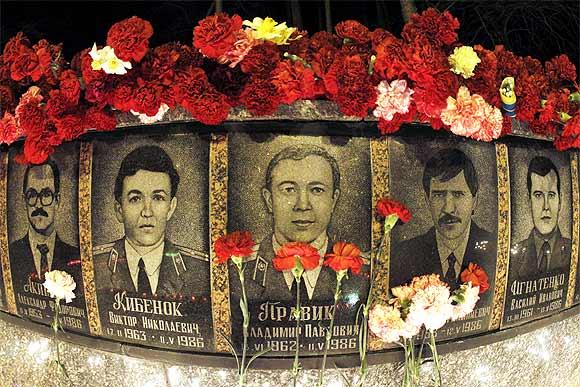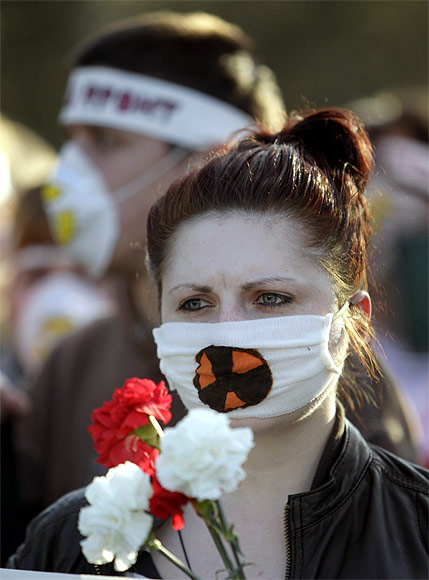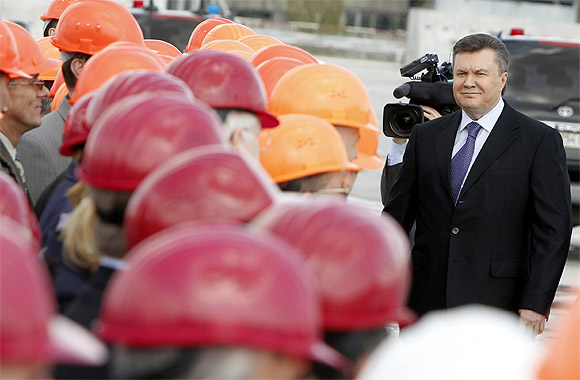Photographs: Gleb Garanich/Reuters
Belarus, Ukraine and Russia marked the 26th anniversary of the Chernobyl disaster, the world's worst civil nuclear accident, on Thursday.
On April 26, 1986, a botched routine safety test at the control room of Reactor number 4 at the Chernobyl nuclear power facility had led to an explosion and a fire that burned for 10 days.
Click on NEXT for more...
Remembering the world's WORST nuclear disaster
Image: Guards of honour march with a wreath during a memorial ceremony for Chernobyl victims in MinskPhotographs: Vasily Fedosenko/Reuters
The explosion released lethal radioactive contamination that quickly spread over tens of thousands of square miles, driving more than a quarter of a million people permanently from their homes.
The area, with several villages that remain deserted till date, is known as the exclusion zone.
Click on NEXT for more...
Remembering the world's WORST nuclear disaster
Image: A woman cries in front of a memorial dedicated to firefighters and workers who died after the Chernobyl nuclear disaster during a night service near the Chernobyl plantPhotographs: Gleb Garanich/Reuters
Nearly 4,000 people died of nuclear radiation from the damaged plant. While 50 workers and firefighters died while trying to contain the radiation, others died after suffering from cancer and leukaemia induced by the radiation.
Click on NEXT for more...
Remembering the world's WORST nuclear disaster
Image: A woman holds a portrait of a victim of the Chernobyl nuclear disaster during a ceremony in KievPhotographs: Anatolii Stepanov/Reuters
Over three lakh people living in the 30-km radius surrounding the Chernobyl Nuclear Power Plant were evacuated after the mishap. But authorities have feared that the radiation spread to areas beyond the evacuated zone, affecting millions of people permanently.
Click on NEXT for more...
Remembering the world's WORST nuclear disaster
Image: A woman holds a portrait of a victim of the Chernobyl nuclear disaster during a ceremony in KievPhotographs: Anatolii Stepanov/Reuters
According to unofficial estimates, nearly two lakh people died due to health complications arising out of their exposure to nuclear radiation.
Scientists claim that between 75,000 to one lakh people died prematurely due to cancer induced by the nuclear disaster.
Click on NEXT for more...
Remembering the world's WORST nuclear disaster
Image: Activists wearing masks with a radioactive danger sign attend an opposition protest to mark the Chernobyl nuclear accident in MinskPhotographs: Vasily Fedosenko/Reuters
The Chernobyl nuclear disaster and Fukushima Daiichi nuclear disaster (triggered by the earthquake and Tsumani that hit Japan ) are the only two mishaps that are considered level 7 events on the International Nuclear Event Scale.
The catastrophe raised serious questions about the failure of safety mechanisms to contain the radiation and the indiscriminate harnessing of nuclear power.
Click on NEXT for more...
Remembering the world's WORST nuclear disaster
Image: Ukraine's President Viktor Yanukovich speaks with workers during a ground-breaking ceremony for a new containment shelter to be built at the site of the Chernobyl nuclear plant near Chernobyl cityPhotographs: Gleb Garanich /Reuters
At the time of the Chernobyl disaster, Belarus, Ukraine and Russia were all part of the erstwhile USSR or Soviet Union. The secretive Communist nation didn't release any information about the disaster and its magnitude till much later.
Click on NEXT for more...
Remembering the world's WORST nuclear disaster
Image: A hazard sign indicating radiation is seen in front of a containment shelter for the damaged fourth reactor at the Chernobyl nuclear power plantPhotographs: Gleb Garanich /Reuters
The extent of the disaster was revealed when the radioactive radiation reached nations like Finland and Sweden, alerting the Western world about the major mishap.
Till then, USSR had kept quiet about the Chernobyl disaster even as it evacuated lakhs of locals from the radiation-hit areas within 36 hours.
Click on NEXT for more...









article